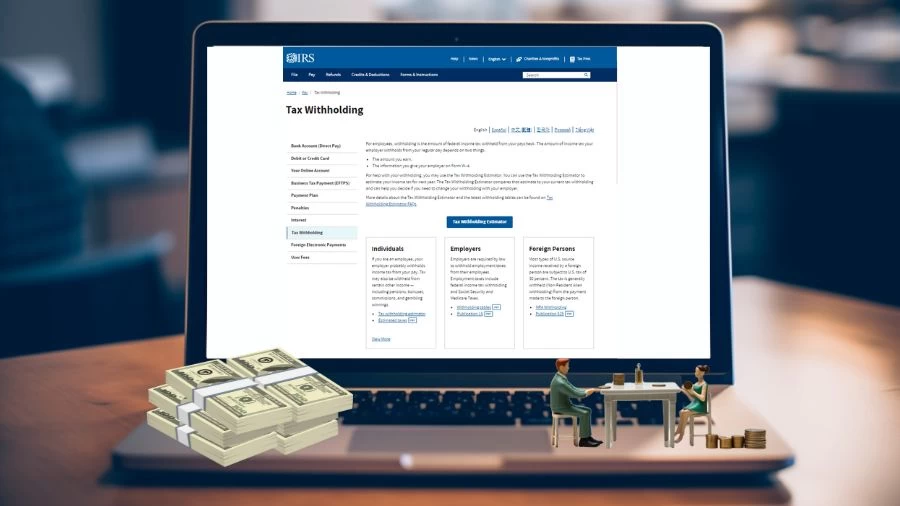
What is Federal Withholding Tax? What Does It Mean to Claim Exemption From Withholding?
Federal Withholding Tax is deducted from income for taxes, adjusted by factors, and claiming exemption means temporary non-liability through accurate Form W-4 submission.
Published Aug 04, 2023 | Updated Dec 18, 2023 | 📖 6 min read
What is Federal Withholding Tax?
Federal withholding tax is the amount taken from an employee's paycheck by their employer and submitted to the federal government to cover income tax liabilities. This withholding is calculated based on various factors, including the employee's income, filing status, and any allowances claimed on their W-4 form.
The purpose of federal withholding tax is to ensure that individuals contribute toward their annual tax liability gradually throughout the year, rather than facing a significant tax bill during the filing season. By withholding a portion of each paycheck, the system helps taxpayers manage their obligations and maintain financial stability.
The withholding process involves employers using IRS guidelines and tax tables to determine the appropriate amount to deduct. Employees can adjust their withholding by submitting a new W-4 form to their employer, updating information that affects the calculation. It's crucial for individuals to understand their tax situation and make accurate withholding adjustments to avoid overpaying for underpaying taxes, resulting in a balanced and predictable tax outcome.
What Does It Mean to Claim Exemption From Withholding?
Claiming exemption from withholding involves an individual informing their employer that they should be excluded from having federal income taxes deducted from their paychecks. This status is often temporary and is contingent upon meeting IRS-specified criteria. Eligibility for exemption may be based on conditions such as having no tax liability in the preceding year and expecting none in the current year.
To ensure accurate withholding, individuals must correctly fill out and submit a Form W-4 claiming exemption. It's crucial to promptly update the W-4 if there are changes in their circumstances that affect their exemption status.
How Does Tax Withholding Work?
Tax withholding is the process through which an employer deducts a specified amount from an employee's paycheck, directing it to the federal government to cover income tax responsibilities. Determined by details provided in the employee's W-4 form, such as income level and filing status, this mechanism ensures individuals make ongoing contributions to their taxes, preventing imbalances during annual tax filings.
The objective is to set withholding at a level where individuals neither owe additional taxes nor receive substantial refunds, avoiding the scenario of lending money interest-free to the government throughout the year.
Enter the world of MarketsHost, where financial clarity meets business excellence. Explore, envision, and rise.
Withholding Taxes
Withholding tax is a taxation system where employers deduct income tax directly from employees' wages before disbursing salaries. This process is applicable to a broad spectrum of U.S. workers, encompassing both residents and nonresident aliens earning income within the United States.
The deducted amount serves as a credit against the annual income tax liability, leading to either refunds or additional tax owed based on the final tax calculation. Functioning as a pay-as-you-go tax system, the withholding amount is influenced by factors such as the individual's income level and filing status.
States often have their own withholding systems, and this practice has historical roots dating back to the Civil War, playing a vital role in funding programs like Social Security and Medicare. Precision in calculating withholding is paramount to ensure compliance with tax obligations.
What Are the Types of Withholding Taxes?
Withholding taxes play a crucial role in the U.S. tax system, encompassing U.S. Resident Withholding Tax for personal income of residents and Nonresident Withholding Tax for foreign-born individuals earning from U.S. sources.
The former involves employers collecting taxes, reconciled during annual returns, while the latter targets nonresident aliens, guided by IRS regulations and international tax treaties. Understanding these categories is vital for navigating the U.S. tax framework.
U.S. Resident Withholding Tax
This type of withholding tax applies to U.S. residents and is commonly associated with personal income. Employers in the United States are responsible for collecting this tax and remitting it to the government. It is deducted from employees' paychecks, and the remaining tax liability is settled when individuals file their annual tax returns. If too much tax is withheld, individuals receive a tax refund, but if not enough tax is held back, they owe money to the IRS.
It's recommended to have approximately 90% of estimated income taxes withheld to avoid underpayment or overpayment throughout the year. Investors and independent contractors are exempt from withholding taxes but must pay quarterly estimated taxes to avoid penalties.
Nonresident Withholding Tax
Nonresident withholding tax is imposed on nonresident aliens to ensure that the correct taxes are paid on income derived from sources within the United States. Nonresident aliens are foreign-born individuals who have not met the criteria for U.S. residency.
They must file Form 1040NR if engaged in a trade or business in the U.S. There are standard IRS deduction and exemption tables to determine tax liability, and tax treaties between the U.S. and other countries can also influence withholding tax obligations for nonresident aliens.
How to Determine Your Federal Tax Withholding?
Managing your federal tax withholding is essential for financial stability. This step-by-step guide outlines key strategies to determine the right amount to withhold from your paycheck, ensuring accurate compliance with tax obligations. Whether evaluating previous tax returns, performing a mock tax return, or adjusting your Form W-4, these steps help maintain financial balance and prevent surprises during tax season.
Evaluate Last Year's Taxes
- If your financial situation hasn't changed significantly since your last tax return, review your previous year's tax liability.
- Divide the total amount you owed last year by 12. This will give you a monthly estimate of how much you should be withholding from each paycheck.
Perform a Mock Tax Return
- For a more precise estimate, especially if you've experienced significant financial changes, consider doing a mock tax return.
- Use free online tax software to calculate your expected tax liability based on your current financial situation.
Determine Monthly Withholding
- Once you have the estimated annual tax liability from your mock tax return, divide it by the number of paychecks you receive per year.
- For bi-weekly paychecks, divide by 26. For semi-monthly paychecks, divide by 24.
- For example, if your annual tax bill is $4,000, divide it by 24, which equals $167. This amount should be withheld from each paycheck to meet your tax obligation.
Update Your W-4
- Whenever a significant life event occurs that impacts your finances, such as buying a home, getting married, or having a child, update your Form W-4 immediately to ensure accurate withholding.
- Also, review your tax refund or tax bill from the previous year to identify any consistent patterns.
Check and Adjust Your W-4
- Request a copy of your current W-4 from your payroll department or check your online payroll service if available.
- Review your W-4 and make necessary adjustments based on your calculations or significant life changes.
- You can download and complete a revised W-4 form from the IRS website to provide to your employer.
- Remember, you can modify your W-4 at any time, so don't delay adjustments after a major life change.
What is Federal Withholding Tax - FAQs
1. What is Federal Withholding Tax?
Federal withholding tax is the amount deducted from an employee's paycheck by their employer to remit to the federal government for income taxes.
2. How do I claim exemption from withholding?
You can claim exemption from withholding by filling out Form W-4 and indicating your exemption status if you expect to have no tax liability for the year.
3. What is a withholding allowance?
A withholding allowance is a deduction that reduces the amount of income tax withheld from an employee's paycheck.
4. How is the withholding allowance calculated?
The withholding allowance is determined based on factors such as the number of dependents, filing status, and total income.
5. What is the purpose of withholding allowances?
Withholding allowances help ensure that the correct amount of taxes is withheld throughout the year, preventing underpayment or overpayment during tax filing.




